4. SQL function¶

pgRouting functions provide low level interface.
When developing for a higher level application, the requirements need to be represented in the SQL queries. As these SQL queries get more complex, it is desirable to store them in postgreSQL stored procedures or functions. Stored procedures or functions are an effective way to wrap application logic, in this case, related to routing logic and requirements.
4.1. The application requirements¶
In this chapter there are three requirements that follow the same logic. It consists on 2 types of vehicles and the pedestrian routing:
Particular vehicle:
Circulate on the whole Prizren area. - Do not use steps, footway, path.
Speed is the default speed from OSM information.
Taxi vehicle:
Circulate on a smaller area near “Inovation and Training Park”.
Bounding box:
(20.73,42.20891,20.76,42.23)Do not use steps, footway, path
Speed is 10% faster than the Particular vehicles.
Pedestrians:
Walk on the whole Prizren area.
Can not circulate on motorways and on primary segments.
The speed is
2 mts/sec.
- A front end needs the following routing information:
seq - A unique identifier of the rows
gid - The segment’s identifier
name - The segment’s name
length - The segment’s length
seconds - Number of seconds to traverse the segment
azimuth - The azimuth of the segment
route_geom - The routing geometry
route_readable - The geometry in human readable form.
and it needs to work based on the graph, and the OSM identifiers of the vertices.
Design of the function
The function to be created wrk_dijkstra with the following input parameters and
output columns:
Input parameters
Name |
Type |
Description |
|---|---|---|
edges_subset |
REGCLASS |
The table/view that is going to be used for processing |
source_osm |
BIGINT |
The OSM identifier of the departure location. |
target_osm |
BIGINT |
The OSM identifier of the destination location. |
output columns
Name |
Type |
Description |
|---|---|---|
seq |
INTEGER |
A unique number for each result row. |
id |
BIGINT |
The edge identifier. |
name |
TEXT |
The name of the segment. |
seconds |
FLOAT |
The number of seconds it takes to traverse the segment. |
azimuth |
FLOAT |
The azimuth of the segment. |
length_m |
FLOAT |
The leng in meters of the segment. |
route_readable |
TEXT |
The geometry in human readable form. |
route_geom |
geometry |
The geometry of the segment in the correct direction. |
4.2. Preparing processing graphs¶
4.2.1. Exercise 1: Creating a view for routing¶
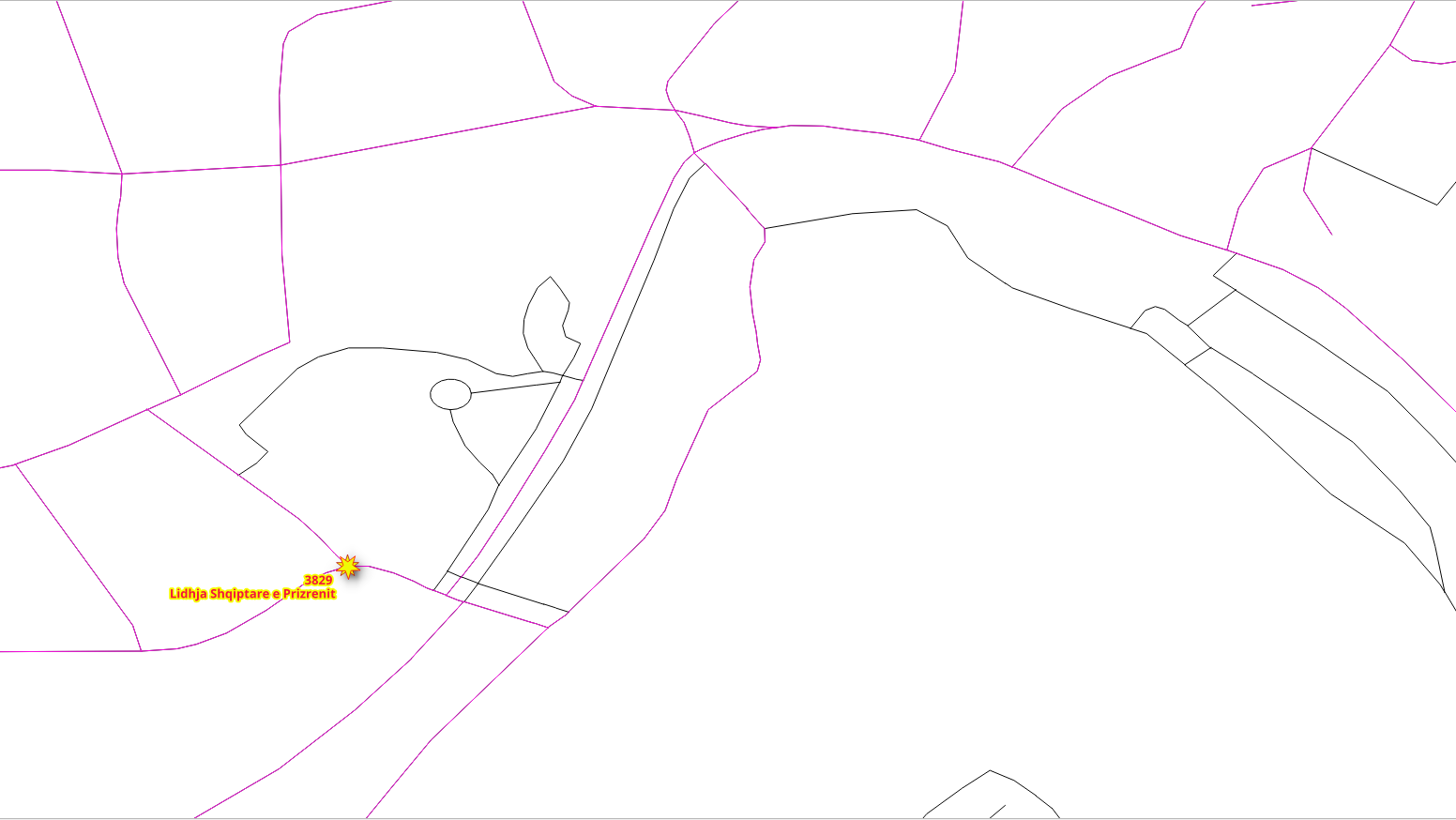
Problem
Create a view with minimal amount of information for processing the particular vehicles.
Routing cost and reverse_cost will be on seconds for routing calculations.
Exclude steps, footway, path segments.
Data needed in the view for further prossesing.
length_m The length in meters.
the_geom The geometry.
Verify the number of edges was reduced.
Solution
Creating the view:
The source and target requirements for the function are to be with OSM identifiers. (line 6)
The
costandreverse_costare in terms of seconds. (line 7)The additional parameters length_m and the_geom. (line 8)
JOINwith the configuration:Exclude steps, footway, path. (line 11)
If you need to reconstruct the view, first drop it using the command on line 1.
1-- DROP VIEW vehicle_net CASCADE; 2 3CREATE VIEW vehicle_net AS 4 SELECT 5 gid AS id, 6 source_osm AS source, target_osm AS target, 7 cost_s AS cost, reverse_cost_s AS reverse_cost, 8 name, length_m, the_geom 9 FROM ways JOIN configuration AS c 10 USING (tag_id) 11 WHERE c.tag_value NOT IN ('steps','footway','path');
Verification:
Count the rows on the original
ways(line 1)Count the rows on the view
vehicle_net(line 2)
1SELECT count(*) FROM ways; 2SELECT count(*) FROM vehicle_net;
4.2.2. Exercise 2: Limiting the road network within an area¶
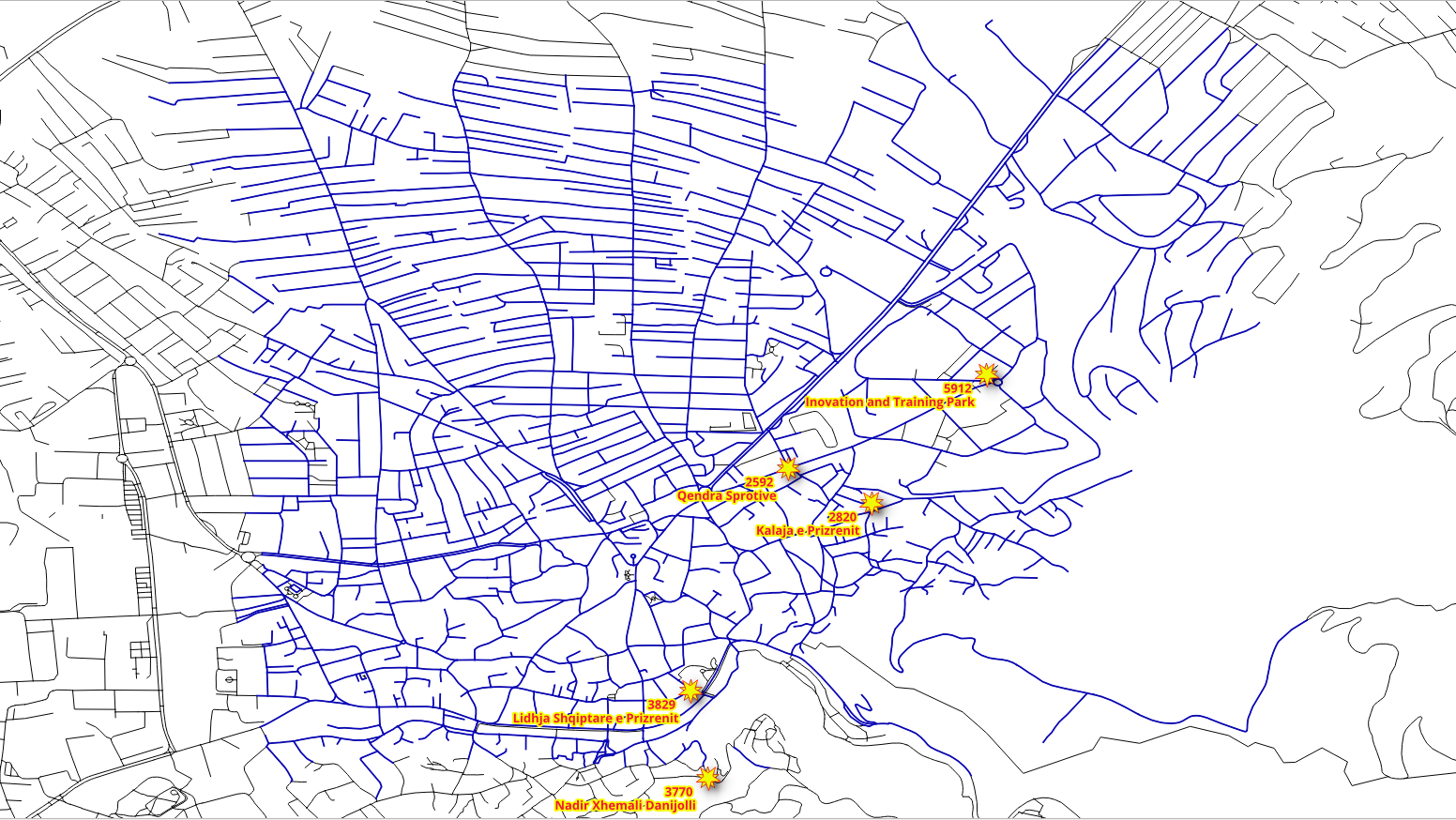
Problem
Create a view
taxi_netfor the taxi:The taxi can only circulate inside this Bounding Box:
(20.73,42.20891,20.76,42.23)The taxi speed is 10% faster than the particular vehicle.
Verify the reduced number of road segments.
Solution
Creating the view:
The graph for the taxi is a subset of the
vehicle_netgraph. (line 9)Can only circulate inside the bounding box:
(20.73,42.20891,20.76,42.23). (line 10)Adjust the taxi’s
costandreverse_costto be 90% of the particular vehicle. (line 7)
1-- DROP VIEW taxi_net; 2 3CREATE VIEW taxi_net AS 4 SELECT 5 id, 6 source, target, 7 cost * 0.90 AS cost, reverse_cost * 0.90 AS reverse_cost, 8 name, length_m, the_geom 9 FROM vehicle_net 10 WHERE vehicle_net.the_geom && ST_MakeEnvelope(20.73,42.20891,20.76,42.23);
Verification:
Count the rows on the original
taxi_net
1SELECT count(*) FROM taxi_net;
4.2.3. Exercise 3: Creating a materialized view for routing pedestrians¶
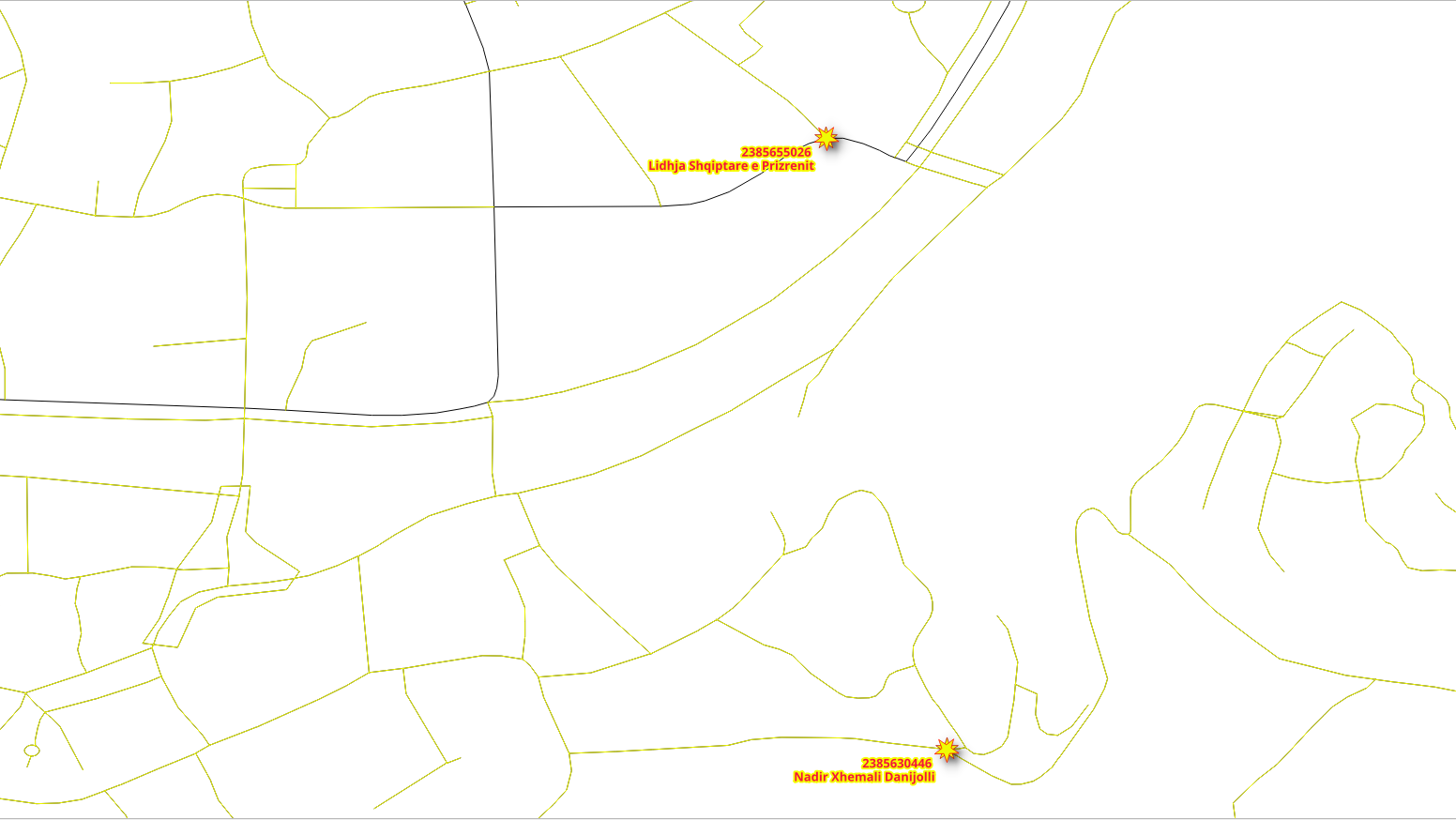
Problem
Create a materialized view with minimal amount of information for processing pedestrians.
Routing cost and reverse_cost will be on seconds for routing calculations.
The speed is
2 mts/sec.
Exclude motorway , primary and secondary segments.
Data needed in the view for further prossesing.
length_m The length in meters.
the_geom The geometry.
Verify the number of edges was reduced.
Solution
Creating the view:
Similar to Exercise 1: Creating a view for routing:
The
costandreverse_costare in terms of seconds with speed of2 mts/sec. (line 7)Exclude motorway, primary and secondary . (line 11)
1-- DROP MATERIALIZED VIEW walk_net; 2 3CREATE MATERIALIZED VIEW walk_net AS 4 SELECT 5 gid AS id, 6 source_osm AS source, target_osm AS target, 7 length_m / 2 AS cost, length_m / 2 AS reverse_cost, 8 name, length_m, the_geom 9 FROM ways JOIN configuration AS c 10 USING (tag_id) 11 WHERE c.tag_value NOT IN ('motorway','primary','secondary');
Verification:
Count the rows on the view
walk_net(line 1)
1SELECT count(*) FROM walk_net;
4.2.4. Exercise 4: Testing the views for routing¶
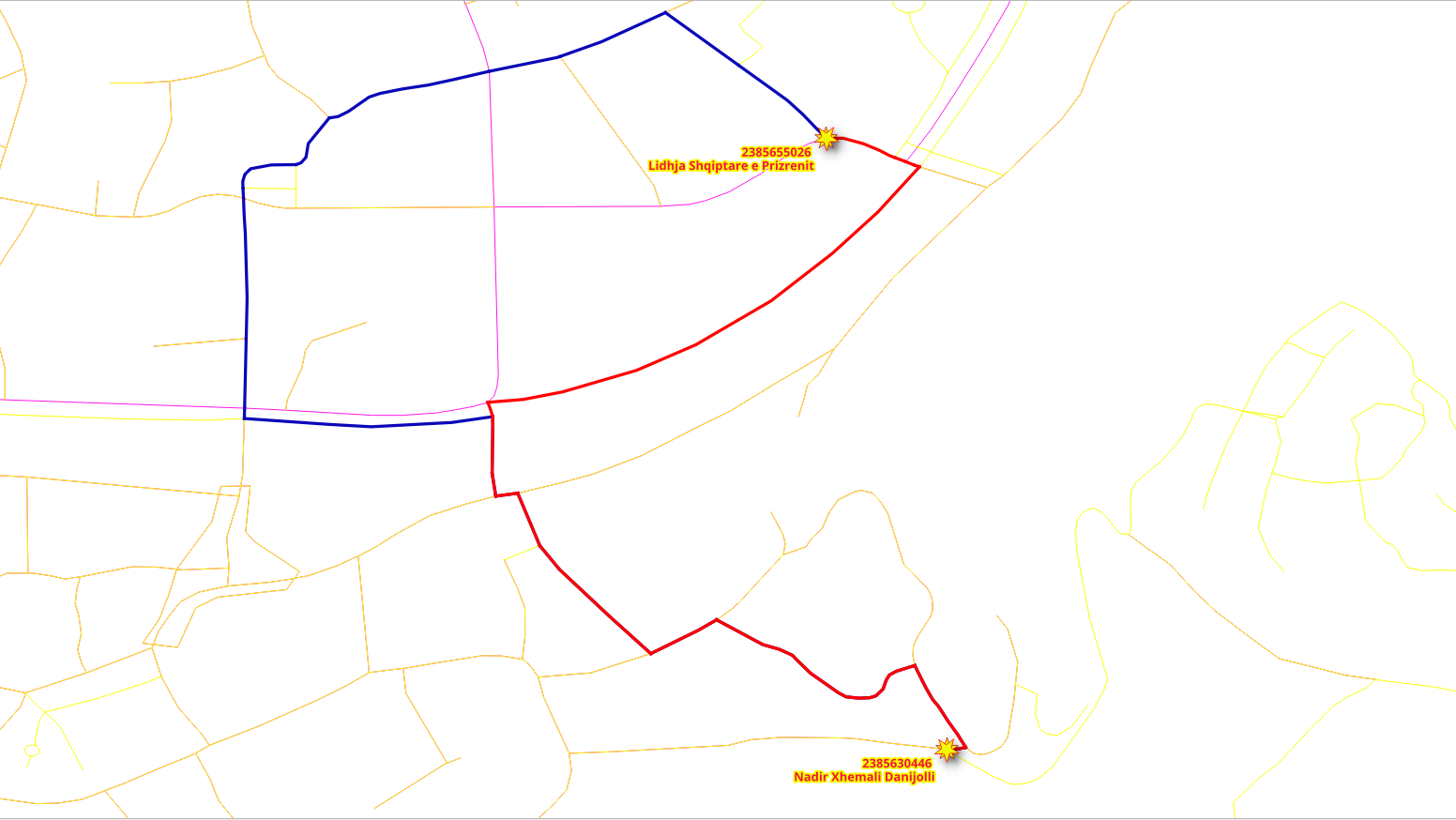
Problem
Test the created views
In particular:
From the “Lidhja Shqiptare e Prizrenit” to the “Nadir Xhemali Danijolli” using the OSM identifier
the views to be tested are:
vehicle_nettaxi_netwalk_net
Only show the following results, as the other columns are to be ignored on the function.
seqedgewith the nameidcostwith the name:seconds
Solution
In general
The departure is Lidhja Shqiptare e Prizrenit with OSM identifier
2385655026.The destination is Nadir Xhemali Danijolli with OSM identifier
2385630446.
For
vehicle_net:vehicle_netis used.Selection of the columns with the corresponding names are on line 1.
The view is prepared with the column names that pgRouting use.
There is no need to rename columns. (line 3)
The OSM identifiers of the departure and destination are used. (line 4)
1SELECT seq, edge AS id, cost AS seconds 2FROM pgr_dijkstra( 3 'SELECT * FROM vehicle_net', 4 2385655026, 2385630446);
For
taxi_net:Similar as the previous one but with
taxi_net. (line 3)The results give the same route as with
vehicle_netbutcostis lower
1SELECT seq, edge AS id, cost AS seconds 2FROM pgr_dijkstra( 3 'SELECT * FROM taxi_net', 4 2385655026, 2385630446);
For
walk_net:Similar as the previous one but with
walk_net. (line 3)The results give a different route than of the vehicles.
1SELECT seq, edge AS id, cost AS seconds 2FROM pgr_dijkstra( 3 'SELECT * FROM walk_net', 4 2385655026, 2385630446);
Note
From these queries, it can be deduced that what we design for one view will work
for the other views. On the following exercises only vehicle_net will be used, but
you can test the queries with the other views.
4.2.5. Exercise 5: Get additional information¶
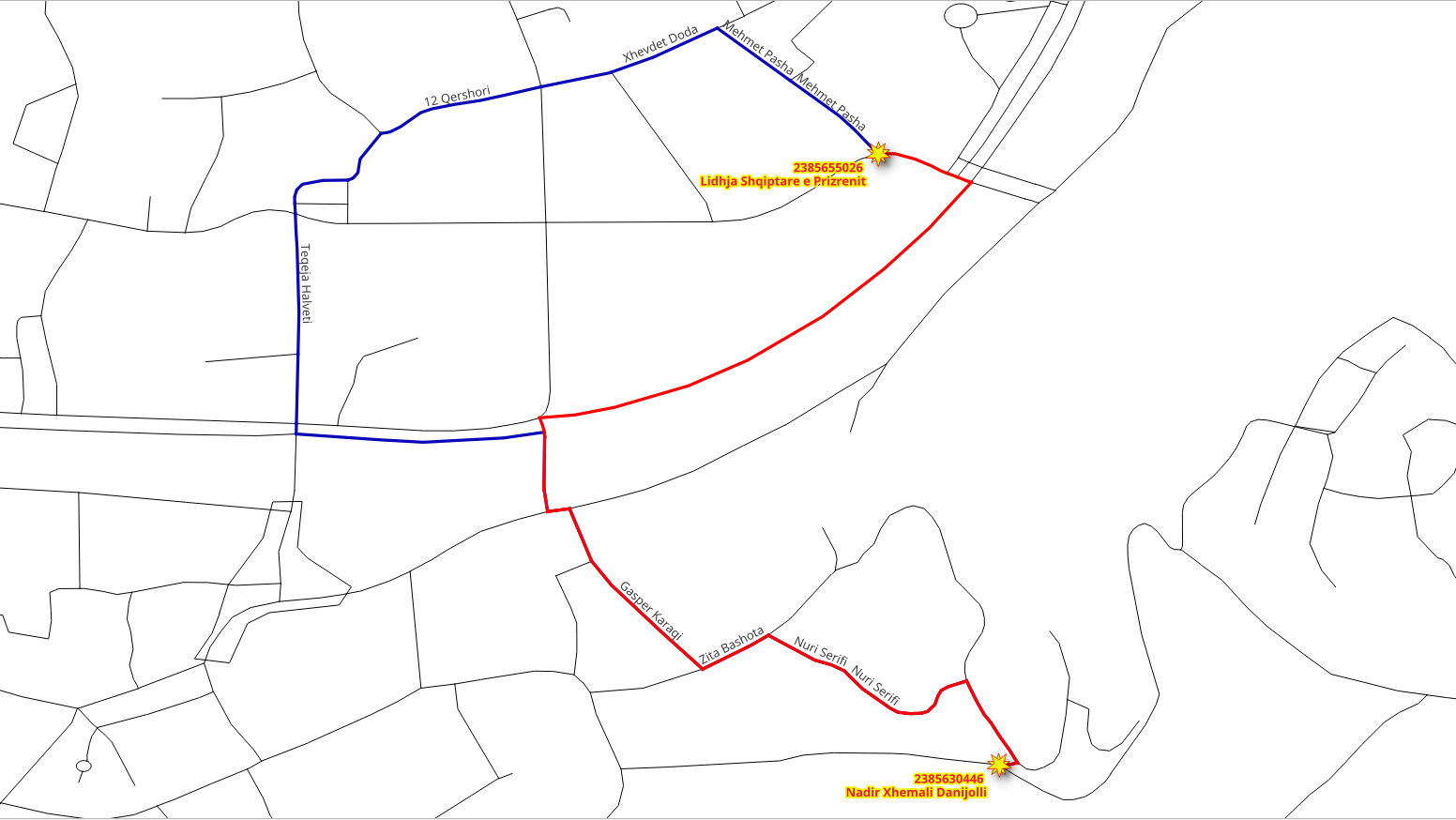
Problem
From Lidhja Shqiptare e Prizrenit to Nadir Xhemali Danijolli, using OSM identifiers.
additionally to the Exercise 4: Testing the views for routing results also get information found on the edges subset:
namelength_m
Solution
The query from Exercise 4: Testing the views for routing used as a subquery named
results(not highlighted lines 5 to 9)The
SELECTclause containsAll the columns of
results. (line 2)The
nameand thelength_mvalues. (line 3)
A
LEFT JOINwithvehicle_netis needed to get the additional information. (line 10)Has to be
LEFTbecause there is a row withid = -1that does not exist onvehicle_net
1SELECT
2 results.*,
3 name, length_m
4FROM (
5 SELECT seq, edge AS id, cost AS seconds
6 FROM pgr_dijkstra(
7 'SELECT * FROM vehicle_net',
8 2385655026, 2385630446)
9 ) AS results
10LEFT JOIN vehicle_net
11 USING (id)
12ORDER BY seq;
4.3. Geometry handling¶
4.3.1. Exercise 6: Route geometry (human readable)¶

Problem
From the Lidhja Shqiptare e Prizrenit to the Nadir Xhemali Danijolli, additionally get the geometry in human readable form.
Additionally to the Exercise 4: Testing the views for routing results also get information found on the edges subset of:
the_geomin human readable form named asroute_readable
Tip
WITH provides a way to write auxiliary statements in larger queries.
It can be thought of as defining temporary tables that exist just for one query.
Solution
The query from Exercise 4: Testing the views for routing used as a subquery named
resultsthis time in a WITH clause. (not highlighted lines 2 to 6)The
SELECTclause contains:All the columns of
results. (line 8)The
the_geomprocessed withST_AsTextto get the human readable form. (line 9)Renames the result to
route_readable
Like before
LEFT JOINwithvehicle_net. (line 11)
1WITH results AS (
2 SELECT seq, edge AS id, cost AS seconds
3 FROM pgr_dijkstra(
4 'SELECT * FROM vehicle_net',
5 2385655026, 2385630446)
6 )
7SELECT
8 results.*,
9 ST_AsText(the_geom) AS route_readable
10FROM results
11LEFT JOIN vehicle_net
12 USING (id)
13ORDER BY seq;
4.3.2. Exercise 7: Route geometry (binary format)¶
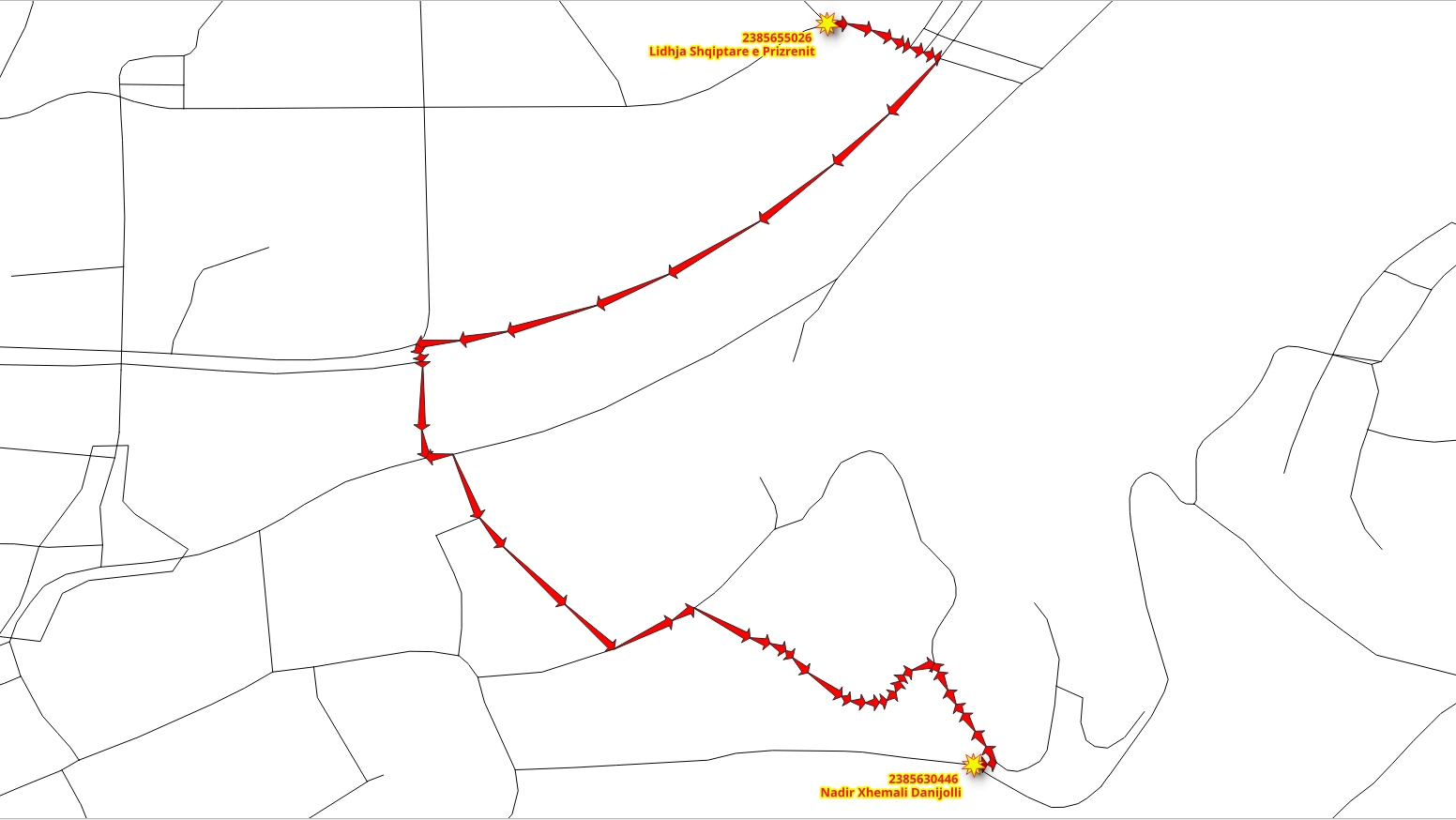
Problem
From the Lidhja Shqiptare e Prizrenit to Nadir Xhemali Danijolli, the geometry in binary format.
Additionally to the Exercise 4: Testing the views for routing results also get information found on the edges subset of:
the_geomin binary format with the nameroute_geom
Solution
The query from Exercise 6: Route geometry (human readable) used;
The
SELECTclause contains:The
the_geomincluding the renaming (line 9)
1WITH results AS (
2 SELECT seq, edge AS id, cost AS seconds
3 FROM pgr_dijkstra(
4 'SELECT * FROM vehicle_net',
5 2385655026, 2385630446)
6 )
7SELECT
8 results.*,
9 the_geom AS route_geom
10FROM results
11LEFT JOIN vehicle_net
12 USING (id)
13ORDER BY seq;
4.3.3. Exercise 8: Route geometry directionality¶
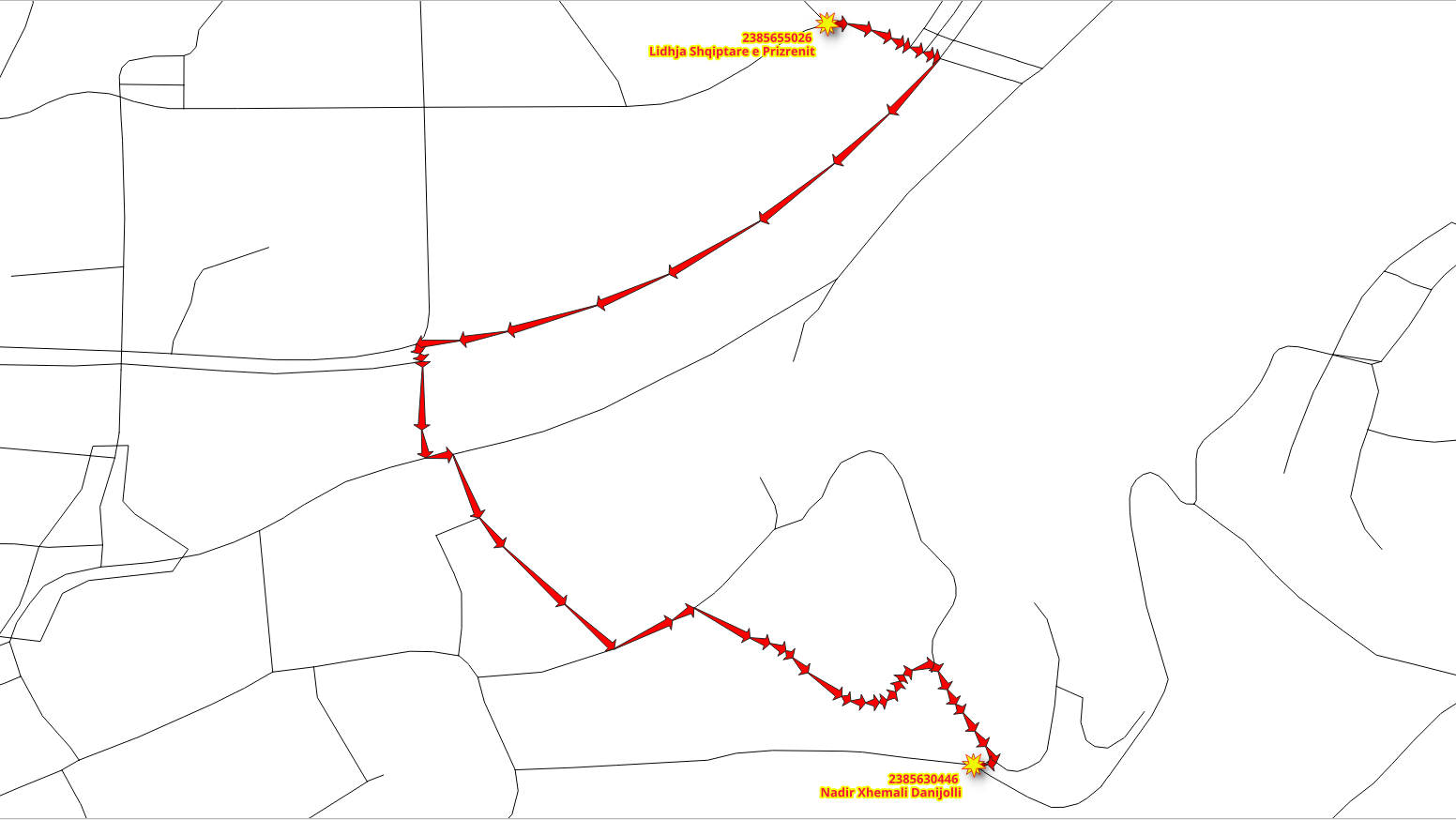
Inspecting the detail image of Exercise 7: Route geometry (binary format) there are arrows that do not match the directionality of the route.
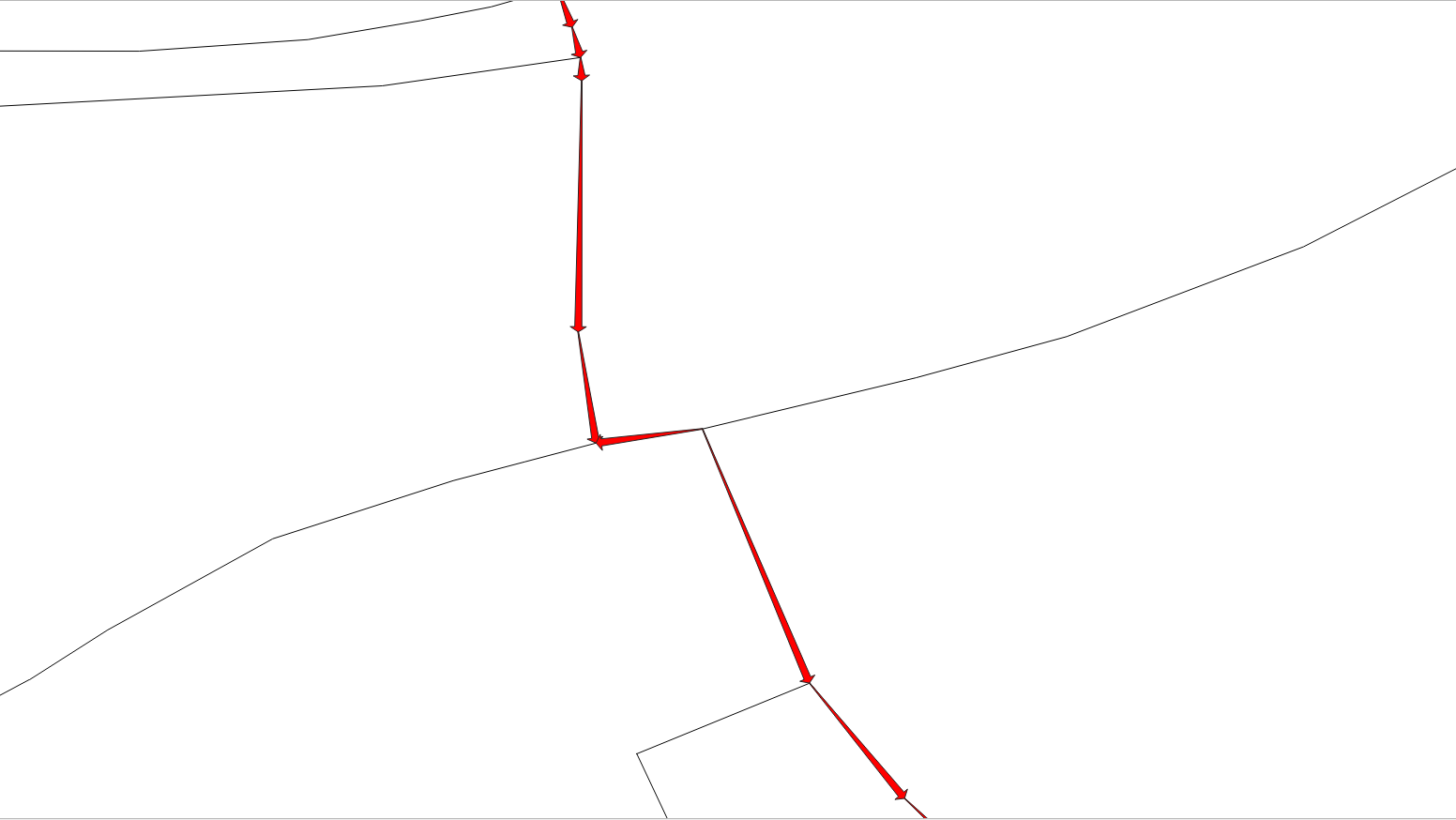
Inspecting the a detail of the results of Exercise 6: Route geometry (human readable)
To have correct directionality, the ending point of a geometry must match the starting point of the next geometry
Lines 2 and 3 do not match that criteria
1 2 | 4478 | 0.39466494779291583 | LINESTRING(20.7435087 42.2108632,20.7435561 42.2108454)
2 3 | 28 | 0.3411414239505941 | LINESTRING(20.7435561 42.2108454,20.7435965 42.2108292)
Problem
From Lidhja Shqiptare e Prizrenit to Nadir Xhemali Danijolli,
Additionally to the Exercise 4: Testing the views for routing results also get information found on the edges subset of:
the_geomin human readable form named asroute_readablethe_geomin binary format with the nameroute_geomBoth columns must have the geometry fixed for directionality.
Solution
To get the correct direction some geometries need to be reversed:
Reversing a geometry will depend on the
nodecolumn of the query to dijkstra (line 3)That
nodeis not needed on the ouput of the query, so explicitly naming required columns at line 9.
A conditional
CASEstatement that returns the geometry in human readable form:Of the geometry when
nodeis thesourcecolumn. (line 11)Of the reversed geometry when
nodeis not thesourcecolumn. (line 12)
A conditional
CASEstatement that returns:The reversed geometry when
nodeis not thesourcecolumn. (line 16)The geometry when
nodeis thesourcecolumn. (line 17)
1WITH results AS (
2 SELECT seq, edge AS id, cost AS seconds,
3 node
4 FROM pgr_dijkstra(
5 'SELECT * FROM vehicle_net',
6 2385655026, 2385630446)
7 )
8SELECT
9 seq, id, seconds,
10 CASE
11 WHEN node = source THEN ST_AsText(the_geom)
12 ELSE ST_AsText(ST_Reverse(the_geom))
13 END AS route_readable,
14
15 CASE
16 WHEN node = source THEN the_geom
17 ELSE ST_Reverse(the_geom)
18 END AS route_geom
19
20FROM results
21LEFT JOIN vehicle_net USING (id)
22ORDER BY seq;
4.3.4. Exercise 9: Using the geometry¶
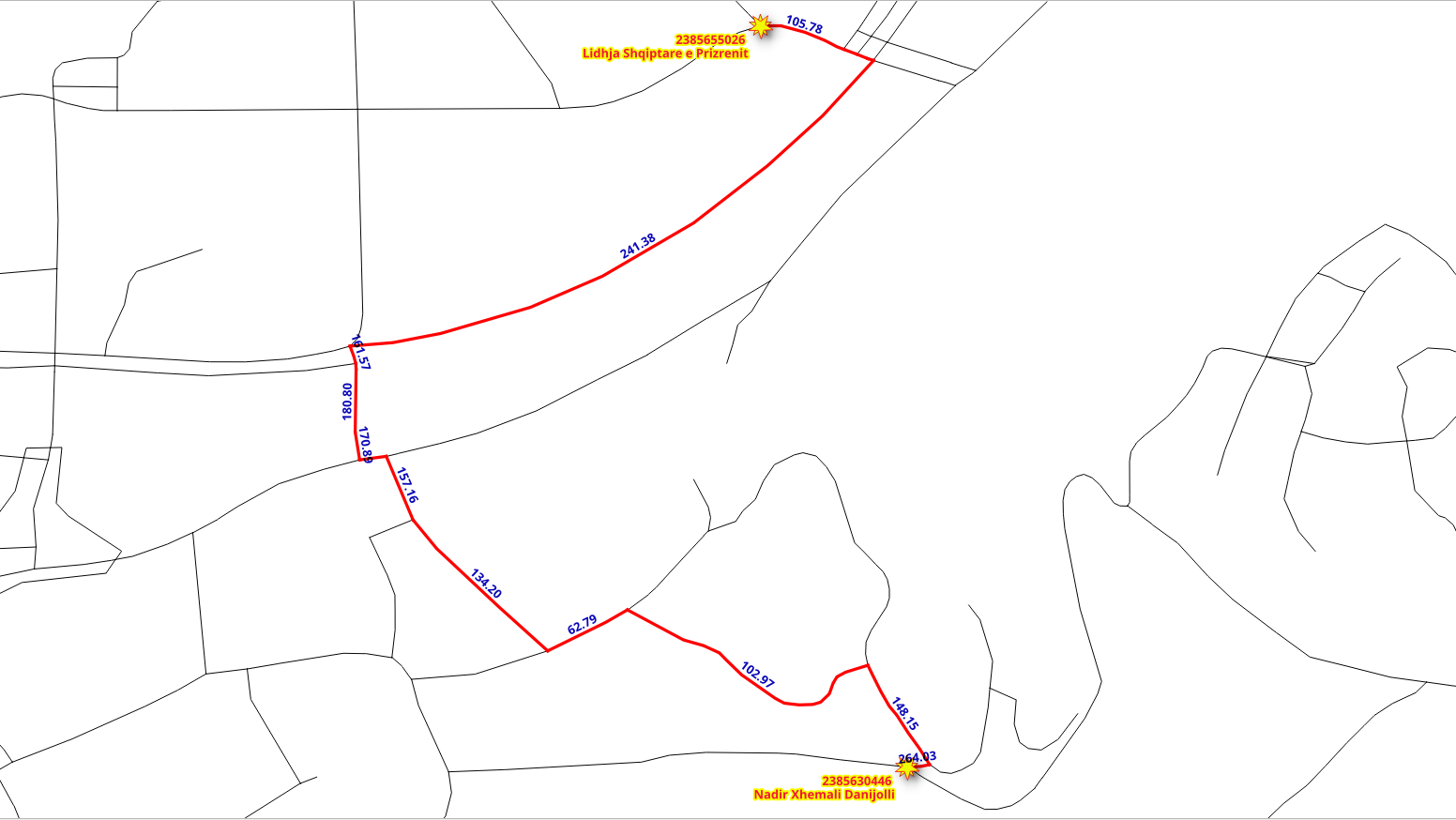
There are many geometry functions in PostGIS, the workshop already covered some of them like
ST_AsText, ST_Reverse, ST_EndPoint, etc.
This exercise will make use an additional function ST_Azimuth.
Problem
Modify the query from Exercise 8: Route geometry directionality.
Aditionally obtain the azimuth of the correct geometry.
keep the output small:
Even that other columns are calculated only output:
seq,id,secondsand theazimuth
Because
vehicle_netis a subgraph ofways, do theJOINwithways.
Solution
Moving the query that gets the additional information into the
WITHstatement.Naming it
additional. (line 9)
Final
SELECTstatements gets:The requested information. (line 25)
Calculates the azimuth of
route_geom. (line 26)
1WITH
2results AS (
3 SELECT seq, edge AS id, cost AS seconds,
4 node
5 FROM pgr_dijkstra(
6 'SELECT * FROM vehicle_net',
7 2385655026, 2385630446)
8 ),
9additional AS (
10 SELECT
11 seq, id, seconds,
12 CASE
13 WHEN node = source THEN ST_AsText(the_geom)
14 ELSE ST_AsText(ST_Reverse(the_geom))
15 END AS route_readable,
16
17 CASE
18 WHEN node = source THEN the_geom
19 ELSE ST_Reverse(the_geom)
20 END AS route_geom
21
22 FROM results
23 LEFT JOIN ways ON (gid = id)
24)
25SELECT seq, id, seconds,
26 degrees(ST_azimuth(ST_StartPoint(route_geom), ST_EndPoint(route_geom))) AS azimuth
27FROM additional
28ORDER BY seq;
4.4. Creating the Function¶
The following function simplifies (and sets default values) when it calls the shortest path Dijkstra function.
Warning
pgRouting uses heavely function overloading:
Avoid creating functions with a name of a pgRouting routing function
Avoid the name of a function to start with pgr_, _pgr or ST_
4.4.1. Exercise 10: Function for an application¶
Problem
Putting all together in a SQL function
function name
wrk_dijkstraShould work for any given view.
Allow a view as a parameter
A table can be used if the columns have the correct names.
sourceandtargetare in terms ofosm_id.The result should meet the requirements indicated at the begining of the chapter
Solution
The signature of the function:
The input parameters are from line 4 to 6.
The output columns are from line 7 to 14 (not highlited).
The function returns a set. (line 16)
1-- DROP FUNCTION wrk_dijkstra(regclass, bigint, bigint);
2
3CREATE OR REPLACE FUNCTION wrk_dijkstra(
4 IN edges_subset REGCLASS,
5 IN source BIGINT, -- in terms of osm_id
6 IN target BIGINT, -- in terms of osm_id
7 OUT seq INTEGER,
8 OUT id BIGINT,
9 OUT seconds FLOAT,
10 OUT name TEXT,
11 OUT length_m FLOAT,
12 OUT route_readable TEXT,
13 OUT route_geom geometry,
14 OUT azimuth FLOAT
15 )
16 RETURNS SETOF record AS
The body of the function:
Appending the view name on line 7 in the
SELECTquery topgr_dijkstra.Using the data to get the route from
sourcetotarget. (line 8)The
JOINwithwaysis necessary, as the views are subset ofways(line 25)
1$BODY$
2 WITH
3 results AS (
4 SELECT seq, edge AS id, cost AS seconds,
5 node
6 FROM pgr_dijkstra(
7 'SELECT * FROM ' || edges_subset,
8 source, target)
9 ),
10 additional AS (
11 SELECT
12 seq, id, seconds,
13 name, length_m,
14 CASE
15 WHEN node = source THEN ST_AsText(the_geom)
16 ELSE ST_AsText(ST_Reverse(the_geom))
17 END AS route_readable,
18
19 CASE
20 WHEN node = source_osm THEN the_geom
21 ELSE ST_Reverse(the_geom)
22 END AS route_geom
23
24 FROM results
25 LEFT JOIN ways ON (gid = id)
26 )
27 SELECT *,
28 degrees(ST_azimuth(ST_StartPoint(route_geom), ST_EndPoint(route_geom))) AS azimuth
29 FROM additional
30 ORDER BY seq;
31$BODY$
32LANGUAGE 'sql';
4.4.2. Exercise 11: Using the function¶
Problem
Test the function with the three views
From the “Lidhja Shqiptare e Prizrenit” to the Nadir Xhemali Danijolli using the OSM identifier
Solution
Use the function on the
SELECTstatementThe first parameter changes based on the view to be tested
1SELECT *
2FROM wrk_dijkstra('vehicle_net', 2385655026, 2385630446);
3
4SELECT *
5FROM wrk_dijkstra('taxi_net', 2385655026, 2385630446);
6
7SELECT *
8FROM wrk_dijkstra('walk_net', 2385655026, 2385630446);
Use the function
Try the function with a combination of the interesting places:
2385630446Nadir Xhemali Danijolli1838481592Qendra Sprotive1840522495Kalaja e Prizrenit6917727056Inovation and Training Park2385655026Lidhja Shqiptare e Prizrenit